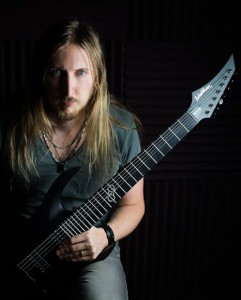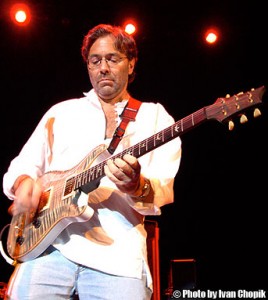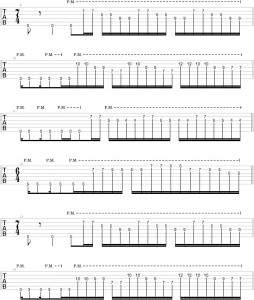At this year’s NAMM convention in Anaheim, CA, I had a chance to meet with Mike Fortin of Randall Amplifiers. By the time Mike joined the Randall team two years ago as exclusive design engineer, he was already established in the high gain amplifier world for his cutting edge designs with Fortin Amplification, his own company which he founded in 2008. Mike’s work has had a major impact on Randall’s new releases, many of which we discussed in detail in our conversation:
IC: How did you get connected with Randall at the time they were doing the big redesign for the company and introducing many new products? How did you get on board with that move and become one of their engineers?
MF: Well, I got contacted by Joe Delaney about three years ago. They were looking to reinvest into Randall; a relaunch of the company, so to speak. They needed an engineer to help them with some design work and, luckily, I got referred to them. They gave me a call and the first thing we worked on was something for Kirk [Hammett]. Joe came up and played some of the amps and talked about buying a couple of designs. We sold them the Meathead design and the Natas. And from there, a lot of this stuff has been the template for the models that are here at NAMM 2014 now.
IC: Let’s actually talk about some of those. What are some of the main introductions here at NAMM 2014?
MF: This year we’re officially launching Ola [Englund’s] signature amp, Satan, which has a different tube complement than some of the other stuff that’s out on the market. We’ve got Scott Ian’s signature amp here, and we’ve got a 6-channel amp, which is a variation off of the Meathead design. It has 6 channels, 6 functions, 7 MIDI-programmable functions. Then we have Kirk Hammett’s signature amp. It’s not official on the pricing yet or anything, but it’s similar to [the 667], just minus 3 of the channels. Not many voicing changes, just the third channel has a slightly different voicing than the Meathead version 667.

Randall 667 Amplifier
IC: What are some of the main features that make them stand out from other high-gain amps on the market?
MF: Oh, well… that’s always subjective, right?
IC: It’s broad, but I was reading that you have certain ways of voicing the gain for different tunings and stuff like that…
MF: I’m a guitar player, too, so it’s mainly voicings for things that I like to hear, and I hope that other people will dig it, too.
IC: What are some words that come to mind once you get that voicing right? You get that tone and you’re like… ‘this is what I’m looking for!’ How would you describe that in a couple of words?
MF: Immediacy, not fighting you, and just letting your creativity flow. The guitar is your instrument, but so is this. So it’s kind of like just having everything flow through and not thinking about your instrument or whatever. Once you get that feeling going, just keep playing. It’s usually a good indication that I feel like I’m onto something, if I keep going back to it and keep playing it and playing it. It’s a weird kind of approach; I guess everybody has [theirs].
When we came out with the 6-channel amp we had to come up with a [foot controller] to offer, as well. So, [we made a] very simple, 8-button MIDI-footswitch that powers off of the amp itself, so it’ll feed the power through the cable. And you can assign those buttons in any configuration for either continuous control or program change. It’s very versatile, but compact – just wide enough that even a guy with a big ol’ boot will be able to change channels….
We’re also going back to do some pedals; kind of our first venture into it on this new relaunch. We’ve got this Facepunch pedal, which hits the front end with a 20dB clean boost, and you can select a little bit of a frequency, like a Tube Screamer has… like a 720Hz kind of honk. You can adjust this down so it’s not a preset kind of a deal. You can dial in your thickness or how much cut that you want, and your overall boost level. And then you have the final smoothing tone control. Then we have a Mor pedal, which is you know the guys just want…
IC: More!
MF: Yeah, it’s like 4Hz to 35kHz; it’s flat response, it’s FET-based, which is like a lot of the same field-effect transistors that are in the Randall RG series that we use… And [another] thing that’s really cool is the RGOD, which is the extracted channels out of the RG series. So we’ve got the FET RG Dime tones, and then the blue channel, which is more like the Warhead, all in one box – two channels and a true bypass. You can run this thing right into an effects loop with an amp, take that on a gig, as a fly-gig kind of thing, and it sounds really great. It’s a little bit tighter than the other stuff, so it actually works out really well. And you can use a Facepunch with it to give it a little extra juice.
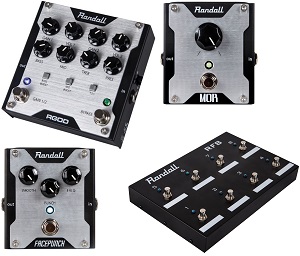
Randall Pedals
IC: Are most of these pedals meant to be used with other amps, or as replacements of some of the features of these amps, or in conjunction… ?
MF: It’s all fair game, yeah. Whatever works – some amps don’t need it, but some guys like to have that extra foot-switchable boost. For guys on the road, every room’s always different. Sometimes you just want to have that safety net that as bodies suck up sound if the club’s full, and you just need that extra little bit for lead work or whatever. Something like that is very easily implemented.
[The pedals have a] battery compartment up on the top… so you can access the battery just by a flip. Then there’s Kirk Hammett’s signature cabinet and the Randall offering, which is also made in USA – V30’s in there, but you’ve got options for speakers.
IC: What separates the Kirk Hammett’s signature cabinet from the standard Randall cabinet?
MF: It’s mostly just cosmetics. It’s got his signature plaque on the bottom and also a blacked-out Randall logo in the bottom corner. The Tolex is different.
IC: But tonally they’re similar?
MF: Yeah, they’re identical.
IC: What’s in store for the rest of the year for you?
MF: After NAMM we’re back to our next phase, which is in a completely different direction from what we’re doing now. So this is our back line, solid tube-amp backdrop, and now we’re going to move on to some other exciting cutting-edge stuff that we wanted to do, but this had to be done first. We’ve got some USA products coming, some co-design products with other companies. It’s going to be cool, very exciting.

Mike Fortin & Ivan Chopik
Ola Englund’s Randall Satan & 667 Demonstration
Ola was kind enough to jam out on both the Satan and 667 amps, while Mike was adjusting their settings to give us a taste of some of the tones they are capable of producing. See for yourself in this video:
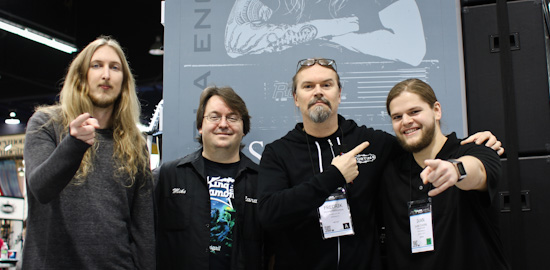
Ola Englund, Mike Fortin, Fredrik Thordendal, Ivan Chopik
John Browne of Monuments checking out Randall Amplifiers
As we were wrapping up the shoot, we spotted John Browne of Monuments arriving at the Randall booth to check out some of these amps for himself. Get another taste of some hi-gain Randall tones, as well as John’s tight riffage in the following video:
[Special thanks to Chris Dingman and Alexander Pierce for their fantastic video work, as well as Monty Jay for letting us use his closeup photo of the Kirk Hammett signature amp!]




